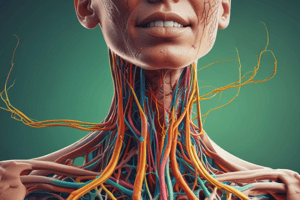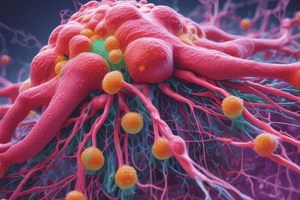Podcast
Questions and Answers
What type of connective tissue surrounds a lymph node and sends trabeculae into it?
What type of connective tissue surrounds a lymph node and sends trabeculae into it?
- Reticular connective tissue
- Loose connective tissue
- Dense connective tissue (correct)
- Adipose tissue
Which type of lymphocyte is predominantly found in the outer zone of the lymph node?
Which type of lymphocyte is predominantly found in the outer zone of the lymph node?
- B lymphocytes (correct)
- T lymphocytes
- Natural killer cells
- Monocytes
Where do lymph nodes typically decrease in size with age?
Where do lymph nodes typically decrease in size with age?
- Only in the thorax
- Only in the abdomen
- Only in the groin
- Systemically throughout the body (correct)
What is the primary function of the sinuses located in the cortex of the lymph node?
What is the primary function of the sinuses located in the cortex of the lymph node?
Which lymph nodes are known to drain the upper limb and breast?
Which lymph nodes are known to drain the upper limb and breast?
Which statement best describes the primary function of the spleen?
Which statement best describes the primary function of the spleen?
What distinguishes the red pulp of the spleen from the white pulp?
What distinguishes the red pulp of the spleen from the white pulp?
Which structure is responsible for collecting lymph from the left upper limb and the left side of the head and neck?
Which structure is responsible for collecting lymph from the left upper limb and the left side of the head and neck?
Which of the following is NOT a feature of the spleen's histology?
Which of the following is NOT a feature of the spleen's histology?
What is the primary role of the splenic capsule?
What is the primary role of the splenic capsule?
Flashcards are hidden until you start studying
Study Notes
Morphology of Lymph Nodes
- Lymph nodes are encapsulated structures, often spherical or kidney-shaped, made of lymphoid tissue.
- Main sources of lymphocytes are lymph nodes and bone marrow, vital for immune response.
- Each lymph node has an outer cortex filled with lymph nodules and an inner medulla.
- Found in axillary and inguinal regions, lymph nodes are most numerous in the thorax and abdomen.
- Lymph nodules in the cortex contain B lymphocytes, essential for antibody production.
- Size of lymph nodes decreases with age unless affected by inflammation or tumors.
- They typically exist in groups connected by lymph vessels, enhancing immune function.
Structure of Lymph Nodes
- Capsule, made of dense connective tissue, envelops the node and projects trabeculae internally.
- Outer Zone includes lymphoid nodules rich in B lymphocytes, important for immune responses.
- Inner Zone (Paracortex) consists of diffuse lymphoid tissue, populated mainly by T lymphocytes.
- Sinuses in the Cortex consist of macrophages and reticular fibers, facilitating lymph filtration.
- Subcapsular Sinus receives lymph from afferent lymphatic vessels and lies beneath the capsule.
- Intermediate Sinuses are adjacent to trabeculae and channel lymph into medullary sinuses.
Medulla of Lymph Nodes
- Composed of medullary cords containing extending B lymphocytes from the inner cortex.
- Medullary Sinuses continue from intermediate sinuses to facilitate lymph flow into efferent vessels.
- Small arteries enter at the hilum to supply the outer cortex, where high endothelial venules (HEVs) are formed.
Main Groups of Lymph Nodes
- Axillary Lymph Nodes drain lymph from the upper limb and breast, leading to the subclavian lymph trunk.
- Inguinal Lymph Nodes receive lymph from lower limbs, draining into external and common iliac nodes.
- Cervical Lymph Nodes collect lymph from the head and neck, crucial for localized immunity.
Main Lymph Channels
- Cisterna Chyli serves as a major drainage point for the abdomen.
- Thoracic Duct collects lymph from the cisterna chyli, left upper limb, and left head/neck area.
- Right Lymphatic Duct drains the right upper quadrant of the body.
- Mesenteric Lymph Nodes form a central system for lymph from mesenteric area's nodes.
- Bronchomediastinal Lymph Nodes receive lymph from tracheobronchial and mediastinal regions.
Spleen Structure
- Located in the upper left abdominal quadrant, the spleen is encased in a capsule of dense connective tissue.
- Trabeculae penetrate the spleen, housing larger blood vessels supplying its internal structure.
Subdivisions of the Spleen
- White Pulp, identified by its whiteness in fresh specimens, is comprised of periarterial lymphoid sheath (PALS) and surrounding T lymphocytes.
- Lymphoid Nodules containing B lymphocytes are distributed within the PALS.
Functions of the Spleen
- Largest collection of lymphoid tissue, the spleen uniquely filters blood and defends against blood-borne antigens.
- Primary site for the destruction of old erythrocytes, facilitating recycling of iron and hemoglobin.
- Produces antibodies and activated lymphocytes, which are released into circulation.
Histology of the Spleen
- Surrounded by a dense connective tissue capsule, which sends trabeculae into the splenic pulp.
- Filled with reticular tissue containing reticular cells, fibers, different blood cells, macrophages, and antigen-presenting cells.
- Splenic pulp consists of white pulp (20%) primarily for immune functions and red pulp for blood filtration and storage.
Functions of Splenic Red and White Pulp
- The spleen monitors blood immunologically, with specialized microvasculature.
- Unique regions within the microvasculature enhance early detection and response to pathogens.
- Trabecular arteries branch from the hilum, leading into the parenchyma populated by T cells, macrophages, and plasma cells.
Morphology of the Spleen
- The spleen represents the largest accumulation of lymphoid tissues found within the abdominal cavity.
- It serves as a critical site for the destruction of aged red blood cells, maintaining healthy blood circulation.
Studying That Suits You
Use AI to generate personalized quizzes and flashcards to suit your learning preferences.




